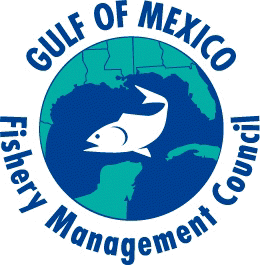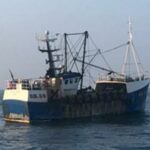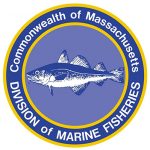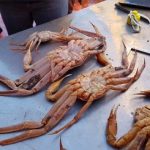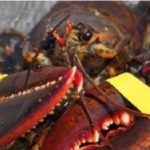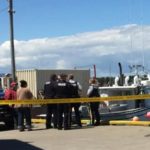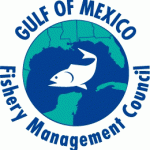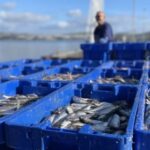Monthly Archives: October 2016
Lu Dochtermann’s letter to James W. Balsiger – You should read it.
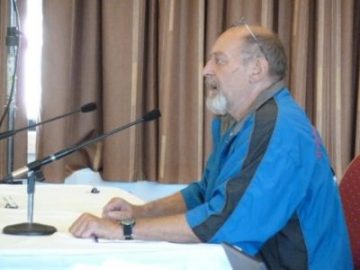 Also addressed are Glenn G. Merrill — Sustainable Fisheries Administrator, and Penny Pritzker, Secretary U.S. Department of Commerce. He cover’s a lot of territory in the letter from by-catch, to catch shares. Dear Sirs: You are both aware of our vessels, F/V North Point and F/V Stormbird who fish BSAI & GOA halibut, crab, and tender salmon in Bristol Bay — and of my significant investment in vessels, pots, gear and quotas for those grounds. Likewise, that my investment is enormously impacted when unforgiving behavior in the trawl groundfish industrialized mega-sized effort strikes at the heart of the sustainability for other bottommost stocks. ,,, In perspective with the fact that “Greed is Good” is increasingly the main motivator in all aspects of economic societies, it is particularly seemly omnipotent in the globalized fishing business, where “bigger is always better” and “the little guy” is meant to be squeezed out as the ‘market liberalization’ theory’s resource corrupt room gets smaller. Read the letter, click here 16:18
Also addressed are Glenn G. Merrill — Sustainable Fisheries Administrator, and Penny Pritzker, Secretary U.S. Department of Commerce. He cover’s a lot of territory in the letter from by-catch, to catch shares. Dear Sirs: You are both aware of our vessels, F/V North Point and F/V Stormbird who fish BSAI & GOA halibut, crab, and tender salmon in Bristol Bay — and of my significant investment in vessels, pots, gear and quotas for those grounds. Likewise, that my investment is enormously impacted when unforgiving behavior in the trawl groundfish industrialized mega-sized effort strikes at the heart of the sustainability for other bottommost stocks. ,,, In perspective with the fact that “Greed is Good” is increasingly the main motivator in all aspects of economic societies, it is particularly seemly omnipotent in the globalized fishing business, where “bigger is always better” and “the little guy” is meant to be squeezed out as the ‘market liberalization’ theory’s resource corrupt room gets smaller. Read the letter, click here 16:18
Poor Striper Spawn Reported in Chesapeake
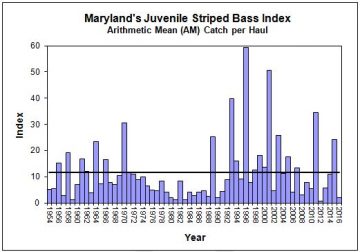 The Maryland Department of Natural Resources announced yesterday that the annual Juvenile Striped Bass Survey indicates that the 2016 striper spawn in the Chesapeake was well below average. However, it also found one-year-old striped bass from last year’s very successful year-class in abundance. Striped bass spawning success is strongly affected by environmental conditions such as rainfall and varies greatly from year-to-year, with occasional large year-classes interspersed with average or below-average year-classes. “While this year’s striped bass index is disappointing, it is not a concern unless we observe poor spawning in multiple, consecutive years,” said Fishing and Boating Services Director David Blazer. Read the rest here 15:03
The Maryland Department of Natural Resources announced yesterday that the annual Juvenile Striped Bass Survey indicates that the 2016 striper spawn in the Chesapeake was well below average. However, it also found one-year-old striped bass from last year’s very successful year-class in abundance. Striped bass spawning success is strongly affected by environmental conditions such as rainfall and varies greatly from year-to-year, with occasional large year-classes interspersed with average or below-average year-classes. “While this year’s striped bass index is disappointing, it is not a concern unless we observe poor spawning in multiple, consecutive years,” said Fishing and Boating Services Director David Blazer. Read the rest here 15:03

A Drone May Save Your Life in the Future.
Drones have many uses—from military strikes to package delivery. One of the most important uses is to save lives. In times of emergency, a drone is often the cheapest and most efficient way to find a missing person, deliver needed medicine, or survey a disaster scene. In the case of cardiac arrest, it could take an EMT ten or more minutes to get to the scene. Brain death occurs in 4 – 6 minutes. An emergency drone can get a defibrillator to a patient within a 5 square mile zone within a minute, increasing the chance of survival from 8 percent to 80 percent. The drone tracks emergency mobile calls and uses GPS to navigate to the crisis. This same drone can be used by the Coast Guard when they are a distance from a capsized boat. Aside from dropping multiple flotation devices to conscious victims to buy time until the Coast Guard reaches them, GPS transmitters in the flotation devices enable the Coast Guard to pull the survivors from the cold water faster. Read the rest here 13:57
Seafood Industry Australia – Industry finds its voice as campaign for a united peak body gains momentum
 A national campaign to form a united peak body for the seafood industry is gaining momentum. Voluntary contributions totalling $406,000 have been secured from the wild catch, aquaculture, post harvest and retail sectors to fund the next two years of forming Seafood Industry Australia. Chair of the implementation group, Veronica Papacosta, said with 52 days left in the campaign, she was confident of getting it across the line. “We’re very close to our minimum target, so I think we’re past the tipping point of whether this’ll happen — it will, which is really, really exciting,” Ms Papacosta said. “But now the pressure is on to make sure we get it right, to make sure we are a national body, to make sure we represent the whole of Australia.” Australia’s, at times, fractured fishing industry has long recognised it needed a clearer, united voice to speak to government and consumers. Read the story here 09:53
A national campaign to form a united peak body for the seafood industry is gaining momentum. Voluntary contributions totalling $406,000 have been secured from the wild catch, aquaculture, post harvest and retail sectors to fund the next two years of forming Seafood Industry Australia. Chair of the implementation group, Veronica Papacosta, said with 52 days left in the campaign, she was confident of getting it across the line. “We’re very close to our minimum target, so I think we’re past the tipping point of whether this’ll happen — it will, which is really, really exciting,” Ms Papacosta said. “But now the pressure is on to make sure we get it right, to make sure we are a national body, to make sure we represent the whole of Australia.” Australia’s, at times, fractured fishing industry has long recognised it needed a clearer, united voice to speak to government and consumers. Read the story here 09:53
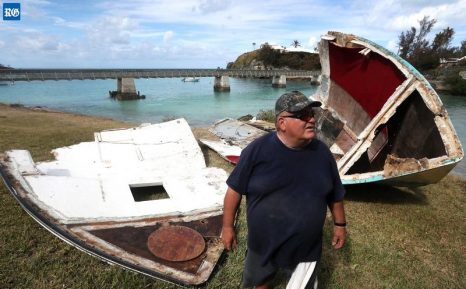
Boat owner describes devastation when his 42ft Bruno get’s ripped apart
The owner of a boat that was ripped apart in Bailey’s Bay by Hurricane Nicole has likened the ordeal to “losing a family member”. The storm not only tore apart Aldo Pace’s boat but also his livelihood as a commercial fisherman and with upwards of $300,000 worth of damage, he has no insurance to fall back on. Mr Pace, 62, got the 42ft Bruno Stillman fishing vessel about 25 years ago, using it for his charter business followed by offshore commercial fishing. He had wanted to take it out of the water but all the boat yards were full. Mr Pace had already called the insurance companies but they said they don’t provide storm cover for boats for Bailey’s Bay as it is a high-risk area. It left him no choice other than to tie down the boat as best he could and hope for the best. Read the story here 09:14
Fire destroys Owls Head lobster boat, community rally’s
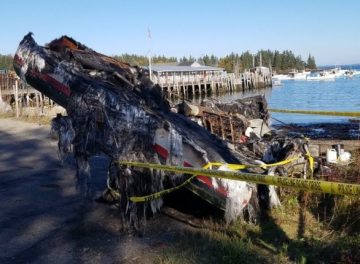 Todd Nickles said the fishing community has rallied to offer its collective hand after his lobster boat was destroyed Saturday night by fire. The cause of the blaze aboard the 31-foot Double Trouble II has not been determined, Nickles said Monday as he stood by the remnants of the burned vessel, which was surrounded by yellow tape. There were no immediate responses to an email message left Monday afternoon with the Maine Department of Public Safety and a phone message for the state fire marshal investigator about the fire. Nickles said he does not believe it was intentionally set. The boat is insured, Nickles said, but he does not know if the insurance covers lost income. Read the story here 08:38
Todd Nickles said the fishing community has rallied to offer its collective hand after his lobster boat was destroyed Saturday night by fire. The cause of the blaze aboard the 31-foot Double Trouble II has not been determined, Nickles said Monday as he stood by the remnants of the burned vessel, which was surrounded by yellow tape. There were no immediate responses to an email message left Monday afternoon with the Maine Department of Public Safety and a phone message for the state fire marshal investigator about the fire. Nickles said he does not believe it was intentionally set. The boat is insured, Nickles said, but he does not know if the insurance covers lost income. Read the story here 08:38
Coast Guard confirms new icebreaker will be ready just in time for Hell to freeze over
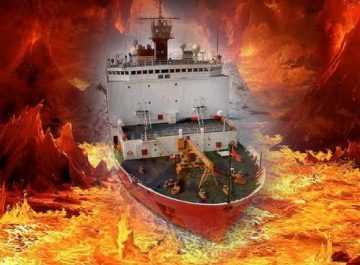 With three icebreakers at over 40 years of use and abuse in the Polar Regions, the Coast Guard finally announced that the new icebreaker currently under construction will be complete just in time for Hell to freeze over. In a recent hearing of the House Subcommittee on the Coast Guard on Monday, chairman Rep. Duncan Hunter (R-Calif.) asked U.S. Coast Guard vice commandant Adm. Charles D. Michel on whether or not a new icebreaker would be constructed at all. Adm. Michel responded with, “Yes, we have been in talks with Lucifer and his Minions of Doom regarding the deadline and we are all in agreement that this timeline works for us.” “This is very exciting,” said former serial killer Ted Bundy, from the the Seventh Circle of Hell. “Our all-knowing and gloriously hateful lord of fire will be able to continue his reign of sin on the unholy all thanks to the speedy manufacturing of Vigor Industrial Shipyard and the US Coast Guard.” Read the rest here 08:17
With three icebreakers at over 40 years of use and abuse in the Polar Regions, the Coast Guard finally announced that the new icebreaker currently under construction will be complete just in time for Hell to freeze over. In a recent hearing of the House Subcommittee on the Coast Guard on Monday, chairman Rep. Duncan Hunter (R-Calif.) asked U.S. Coast Guard vice commandant Adm. Charles D. Michel on whether or not a new icebreaker would be constructed at all. Adm. Michel responded with, “Yes, we have been in talks with Lucifer and his Minions of Doom regarding the deadline and we are all in agreement that this timeline works for us.” “This is very exciting,” said former serial killer Ted Bundy, from the the Seventh Circle of Hell. “Our all-knowing and gloriously hateful lord of fire will be able to continue his reign of sin on the unholy all thanks to the speedy manufacturing of Vigor Industrial Shipyard and the US Coast Guard.” Read the rest here 08:17
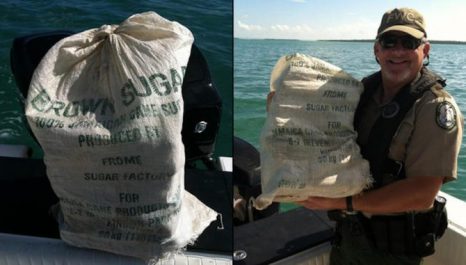
$300,000+ of Marijuana Seized ‘Floating off the Shore’ of Florida over 27 Days
In a span of 27 days, U.S. Customs and Border Patrol, in cooperation with the U.S. Coast Guard, recorded the seizure of nearly 400 pounds of marijuana found floating off the coast of Florida. Between September 15 and October 12 fifteen separate drug seizure events have occurred in various parts of the Florida Keys and East Florida coastline, explained CBP in a press release. “There has been a significant spike in drugs washing up on shore,” said U.S. Border Patrol Miami Sector Division Chief, Todd Bryant. “This is at least partially attributable to improved partnerships across the state but potentially also to a shift in smuggling methods.” The drugs seized in that 27 day span reportedly have a street value of more than $300-thousand. Link 20:26
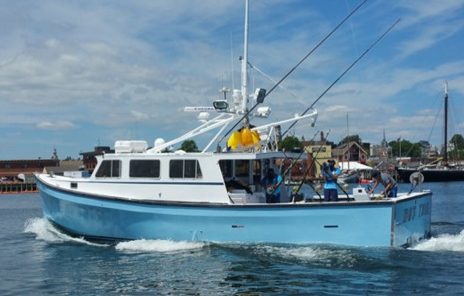
Axalta’s Imron Paint Shines on Fishing Boat Featured on TV Hit Show “Wicked Tuna”
Axalta Coating Systems, a leading global supplier of liquid and powder coatings celebrating its 150th anniversary in the coatings industry, is excited to announce its sponsorship of the Hot Tuna fishing boat featured on National Geographic Channel’s hit show, Wicked Tuna. Axalta’s Imron® MS600™ Single Stage polyurethane topcoat protects and beautifies Captain T.J. Ott’s 39-foot, Hot Tuna boat. The boat is painted in a custom color aptly named Hot Tuna Blue. The boat will be featured in next season’s episodes in winter 2017. Imron MS600 is scientifically engineered to achieve long-lasting high gloss appearance, performance, and corrosion protection specifically for the marine segment. The durability and abrasion resistance of Axalta’s marine coatings help ensure that fishing boats and yachts retain their mirror-like finish longer. “Hot Tuna perfectly showcases our Imron marine coatings,” said Christopher Papa, Axalta Marketing Manager. “Axalta is committed to delivering the industry’s best appearance and corrosion protection, which combine to reflect the attributes that customers have come to value in the Imron brand.” Read the rest here 16:15
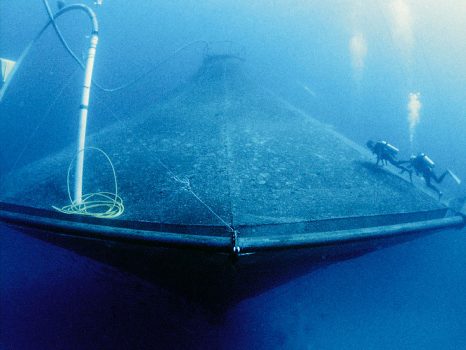
Feds must end push for ocean aquaculture
The world’s oceans are in trouble. Litter, urban runoff, dead zones, leaking oil rigs and other factors put stress on sea life, notably fish, and cause alarming changes in our marine environment. One thing we do know for sure is that we should not be adding stress and pollution to ocean ecosystems. That’s why it is so baffling that we are seeing a renewed major push by the federal government for industrial ocean fish farms. Lobbyists for the companies who build these aquaculture operations would have you believe the industry is a solution for preserving our marine environment by growing fish to ease the need for taking more fish from the wild. In reality, however, these facilities can exacerbate many of the problems already hurting our oceans. Open water fish farms are comprised of giant floating net pens with thousands of fish all eating, excreting and growing in one space. Cages used to contain fish are flow-through, meaning anything from the pens – excess feed, fish wastes, and any chemicals – can go directly into natural waters. Read the rest here 15:18
Pacific Marine Center Expands Capabilities With New Marine Travelift 200CII Boat Hoist (200 TON CAPACITY)
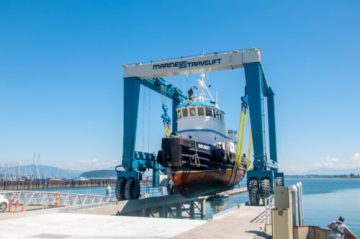 Marine Travelift Inc. has announced the delivery of its 200CII mobile boat hoist to Pacific Marine Center for use at their facility in Anacortes, Washington. Pacific Marine Center is a full service boat yard handling commercial fishing boats, tugs, and pleasure craft. There were two major goals Pacific Marine Center wanted to accomplish with the purchase of the new 200CII boat hoist according to Dave Marshall, Sales Manager at Kendrick Equipment the certified Marine Travelift distributor for the Northwest region of North America. “The customer wanted to penetrate new markets and attract an entirely new class of boat to Anacortes,” Marshall explained. “With the Marine Travelift mobile boat hoist they can pick full capacity with the slings in any position, allowing them to target the shorter and heavier fishing boats they haven’t been able to haul in the past. Expanding their capabilities and targeting these specific size fishing boats is also allowing Pacific Marine Center to accomplishing a second goal of theirs. “Another goal they had was to build a fishing vessel repair business in Anacortes, a gateway to the Pacific Ocean,” said Marshall. “The new mobile boat hoist will allow them to service a strong fleet of commercial vessels that operate throughout Alaska, Canada and the San Juans.” Read the Press Release here 13:46
Marine Travelift Inc. has announced the delivery of its 200CII mobile boat hoist to Pacific Marine Center for use at their facility in Anacortes, Washington. Pacific Marine Center is a full service boat yard handling commercial fishing boats, tugs, and pleasure craft. There were two major goals Pacific Marine Center wanted to accomplish with the purchase of the new 200CII boat hoist according to Dave Marshall, Sales Manager at Kendrick Equipment the certified Marine Travelift distributor for the Northwest region of North America. “The customer wanted to penetrate new markets and attract an entirely new class of boat to Anacortes,” Marshall explained. “With the Marine Travelift mobile boat hoist they can pick full capacity with the slings in any position, allowing them to target the shorter and heavier fishing boats they haven’t been able to haul in the past. Expanding their capabilities and targeting these specific size fishing boats is also allowing Pacific Marine Center to accomplishing a second goal of theirs. “Another goal they had was to build a fishing vessel repair business in Anacortes, a gateway to the Pacific Ocean,” said Marshall. “The new mobile boat hoist will allow them to service a strong fleet of commercial vessels that operate throughout Alaska, Canada and the San Juans.” Read the Press Release here 13:46
Coast Guard medevacs fisherman suffering from seizures, 100 miles off Galveston
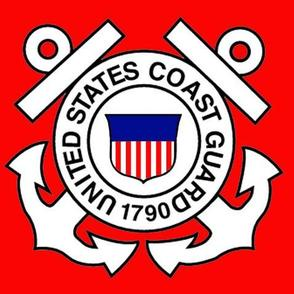 A 38-year-old man was medevaced by a Coast Guard helicopter Sunday, after reports of seizures on a fishing vessel about 100 miles southeast of Galveston, Texas. The crew of the fishing vessel Black Jack IV contacted Coast Guard Sector Houston-Galveston watchstanders on VHF marine band radio channel 16 at about 6:30 p.m., to report that the man was having seizure like symptoms and needed assistance. The watchstanders launched an Air Station Houston MH-65 Dolphin helicopter crew to medevac the man and an Air Station Corpus Christi HC-144 Ocean Sentry airplane crew to provide communications and safety support so far offshore. The helicopter crew hoisted the man, had to stop and refuel on a rig in the gulf and then delivered him to Galveston’s Scholes International Airport, where EMS was standing by to take him to the University of Texas Medical Branch in Galveston. He was reported to be in stable condition. link 13:33
A 38-year-old man was medevaced by a Coast Guard helicopter Sunday, after reports of seizures on a fishing vessel about 100 miles southeast of Galveston, Texas. The crew of the fishing vessel Black Jack IV contacted Coast Guard Sector Houston-Galveston watchstanders on VHF marine band radio channel 16 at about 6:30 p.m., to report that the man was having seizure like symptoms and needed assistance. The watchstanders launched an Air Station Houston MH-65 Dolphin helicopter crew to medevac the man and an Air Station Corpus Christi HC-144 Ocean Sentry airplane crew to provide communications and safety support so far offshore. The helicopter crew hoisted the man, had to stop and refuel on a rig in the gulf and then delivered him to Galveston’s Scholes International Airport, where EMS was standing by to take him to the University of Texas Medical Branch in Galveston. He was reported to be in stable condition. link 13:33
Following court decision Cook Inlet fishermen wait for direction
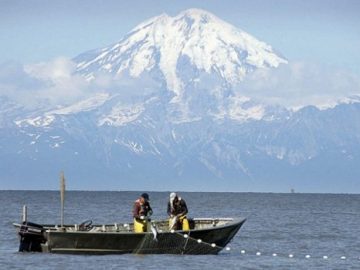 Concerned fishermen gathered at the North Pacific Fishery Management Council’s October meeting in Anchorage to discuss a recent federal court decision that turns control of salmon fisheries in Cook Inlet, Prince William Sound and the Alaska Peninsula over to state management. Though stakeholders brought their suggestions, the council did not direct its staff to any action related to the subject of a salmon FMP. Instead, the council reiterated that the decision will be remanded back to the lower court where it could either be appealed or produce a directive for the council to write a salmon FMP. The North Pacific Fishery Management Council governs federal fisheries, which take place from three to 200 miles offshore. In 2013, industry group United Cook Inlet Drift Association, or UCIDA, filed a lawsuit to repeal a 2011 council decision, which became Amendment 12 to the Alaska salmon fishery management plan, or FMP. The initial suit was rejected by U.S. Alaska District Court Judge Timothy Burgess in September 2014. A three-judge panel of the 9th Circuit unanimously remanded the case back to Burgess with instructions to find in favor the plaintiffs. Read the story here 11:48
Concerned fishermen gathered at the North Pacific Fishery Management Council’s October meeting in Anchorage to discuss a recent federal court decision that turns control of salmon fisheries in Cook Inlet, Prince William Sound and the Alaska Peninsula over to state management. Though stakeholders brought their suggestions, the council did not direct its staff to any action related to the subject of a salmon FMP. Instead, the council reiterated that the decision will be remanded back to the lower court where it could either be appealed or produce a directive for the council to write a salmon FMP. The North Pacific Fishery Management Council governs federal fisheries, which take place from three to 200 miles offshore. In 2013, industry group United Cook Inlet Drift Association, or UCIDA, filed a lawsuit to repeal a 2011 council decision, which became Amendment 12 to the Alaska salmon fishery management plan, or FMP. The initial suit was rejected by U.S. Alaska District Court Judge Timothy Burgess in September 2014. A three-judge panel of the 9th Circuit unanimously remanded the case back to Burgess with instructions to find in favor the plaintiffs. Read the story here 11:48
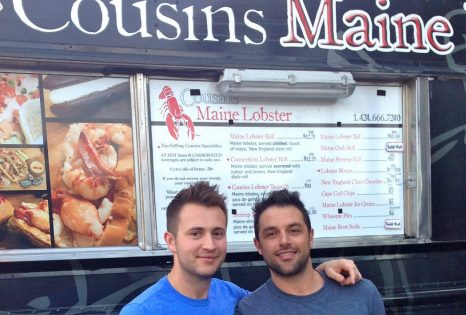
Selling Lobster and Themselves: Cousin’s Maine Lobster Update – What Happened After Shark Tank
The introduction video started off with Jim Tselkis and Sabin Lomac introducing themselves in front of lobster cages, and a Maine harbor. They said that they were cousins from Maine. Jim said that the best part about growing up in Maine was definitely the lobster. He insisted that Maine lobster was the best lobster meat you’ll ever have. He said that they were currently living in Los Angeles. The video flashed to food truck with Cousin’s Maine Lobster emblazoned on the top. Jim peeked out from inside, and asked who wanted some fresh Maine lobster. The two walked into the Shark Tank. They greeted the Sharks, and introduce themselves. They told the Sharks that they were seeking $55,000 in exchange for 5% of Cousin’s Maine Lobster. Jim asked the Sharks to Picture People crowding around lobster Shacks in Maine, waiting for the chance to taste Maine’s signature dish, the lobster roll. Jim said that they brought then Maine lobster experience to Southern California. Read the story here 11:32
N.B. reports first cases of infectious salmon anaemia since 2012
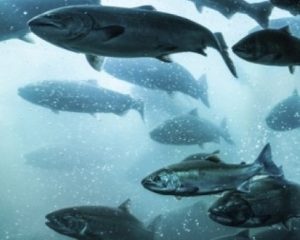 Canada’s Food Inspection Agency is reporting the first New Brunswick cases of infectious salmon anaemia in four years. Four separate incidents have been documented in the Bay of Fundy since March, the most recent on Sept. 20. In each case a single fish was found to have the disease, according to the New Brunswick Department of Agriculture Aquaculture and Fisheries and the Atlantic Canada Fish Farmers Association. “In this particular case, it was four fish,” said Susan Farquharson of the association. “Four cages were depopulated and there hasn’t been any further incidents.” Farquharson claims it’s possible no other fish were contaminated in the four cage sites involved. Smells fishy! Read the story here 11:08
Canada’s Food Inspection Agency is reporting the first New Brunswick cases of infectious salmon anaemia in four years. Four separate incidents have been documented in the Bay of Fundy since March, the most recent on Sept. 20. In each case a single fish was found to have the disease, according to the New Brunswick Department of Agriculture Aquaculture and Fisheries and the Atlantic Canada Fish Farmers Association. “In this particular case, it was four fish,” said Susan Farquharson of the association. “Four cages were depopulated and there hasn’t been any further incidents.” Farquharson claims it’s possible no other fish were contaminated in the four cage sites involved. Smells fishy! Read the story here 11:08
Isle of Man: King scallop licences cut to conserve the stock
 Measures are being introduced to ensure the sustainability of the island’s king scallop fishery. From the start of the 2016/17 season on November 1, the number of licences issued by the Department of Environment, Food and Agriculture (DEFA) to fish for king scallops within the island’s seas will be reduced. Eligibility will be determined by vessels’ track record of fishing for king scallops over the last few seasons, with vessels’ size taken into account. Explaining the need for the measure, Richard Lole, chief executive officer of DEFA, said: ‘In recent years there has been a significant increase in the number of vessels fishing for king scallops in Manx waters and a corresponding increase in the catch. ‘In 2015/16, 4,500 tonnes of king scallops were landed in the island, worth £4 million at the quayside. ‘At the same time, indications are that stock is under increasing pressure, prompting concerns over the sustainability of this valuable fishery. ‘The new measures will protect those vessels that can demonstrate a historic interest and dependence on the fishery while safeguarding the fishery in the long term.’ At the same time, the first stages of a new inshore marine zoning plan will also be introduced by DEFA. Read the story here 08:51
Measures are being introduced to ensure the sustainability of the island’s king scallop fishery. From the start of the 2016/17 season on November 1, the number of licences issued by the Department of Environment, Food and Agriculture (DEFA) to fish for king scallops within the island’s seas will be reduced. Eligibility will be determined by vessels’ track record of fishing for king scallops over the last few seasons, with vessels’ size taken into account. Explaining the need for the measure, Richard Lole, chief executive officer of DEFA, said: ‘In recent years there has been a significant increase in the number of vessels fishing for king scallops in Manx waters and a corresponding increase in the catch. ‘In 2015/16, 4,500 tonnes of king scallops were landed in the island, worth £4 million at the quayside. ‘At the same time, indications are that stock is under increasing pressure, prompting concerns over the sustainability of this valuable fishery. ‘The new measures will protect those vessels that can demonstrate a historic interest and dependence on the fishery while safeguarding the fishery in the long term.’ At the same time, the first stages of a new inshore marine zoning plan will also be introduced by DEFA. Read the story here 08:51
Bering Sea village wants to surround itself with a marine sanctuary
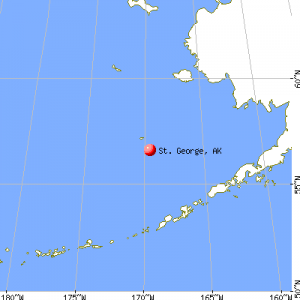 Residents of the smaller of two villages in the Pribilof Islands are asking the federal government to encircle their island with the first national marine sanctuary in Alaska. It’s an effort to protect the fur seals once slaughtered on the Pribilofs and other animal populations they say are plunging dangerously, perhaps because of climate change. The request from the city of St. George is only the second in the state since the Office of National Marine Sanctuaries began accepting sanctuary nominations from the public in 2014. The request, received Oct. 1, may not lead to a sanctuary designation, a process involving years of analysis and significant public engagement, said William Douros, West Coast regional director for the agency, part of the National Oceanic and Atmospheric Administration. Read the story here 08:21
Residents of the smaller of two villages in the Pribilof Islands are asking the federal government to encircle their island with the first national marine sanctuary in Alaska. It’s an effort to protect the fur seals once slaughtered on the Pribilofs and other animal populations they say are plunging dangerously, perhaps because of climate change. The request from the city of St. George is only the second in the state since the Office of National Marine Sanctuaries began accepting sanctuary nominations from the public in 2014. The request, received Oct. 1, may not lead to a sanctuary designation, a process involving years of analysis and significant public engagement, said William Douros, West Coast regional director for the agency, part of the National Oceanic and Atmospheric Administration. Read the story here 08:21
Maine: York Harbor officials, fishermen rally for federal dredging funds
 York town officials are fighting for federal funding to remove a buildup of sediment in York Harbor that threatens to ground local fishermen and recreational boaters alike. As part of their effort to draw attention to the problem, the Town of York Harbor Board staged a demonstration Sunday to show how silt deposits from the York River encroach on mooring areas, forming shoals that crest the water at low tide. A group of fishermen and harbor officials stood atop a mound of sediment that juts above the water level at low tide in the middle of one of the harbor’s basins, near the mouth of the river. York Harbormaster David Hutchinson. “They can’t come in at low tide,” he said. According to Harbor Board Chairman David Webber, York Harbor contains moorings for about 330 commercial and recreational boats. Another 200 boats use the harbor regularly but are moored in private marinas. The harbor generates $12 million to $15 million of economic activity each year, he said. “We don’t want to lose any of it, especially with fishing being such a tough business right now,” Webber said. Read the story here 07:54
York town officials are fighting for federal funding to remove a buildup of sediment in York Harbor that threatens to ground local fishermen and recreational boaters alike. As part of their effort to draw attention to the problem, the Town of York Harbor Board staged a demonstration Sunday to show how silt deposits from the York River encroach on mooring areas, forming shoals that crest the water at low tide. A group of fishermen and harbor officials stood atop a mound of sediment that juts above the water level at low tide in the middle of one of the harbor’s basins, near the mouth of the river. York Harbormaster David Hutchinson. “They can’t come in at low tide,” he said. According to Harbor Board Chairman David Webber, York Harbor contains moorings for about 330 commercial and recreational boats. Another 200 boats use the harbor regularly but are moored in private marinas. The harbor generates $12 million to $15 million of economic activity each year, he said. “We don’t want to lose any of it, especially with fishing being such a tough business right now,” Webber said. Read the story here 07:54
Essex Pinky Schooner Ardelle to be Showcased at The Boatshop at Strawbery Banke in Portsmouth, NH, Saturday, November 12
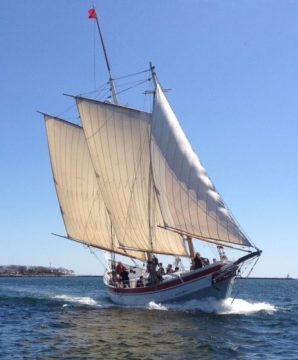 The Boatshop at Strawbery Banke in Portsmouth, NH, will host “An Afternoon with ARDELLE: Harold Burnham and the building of an Essex Schooner” with Essex Shipbuilder and National Heritage Fellow Harold Burham and Photographer Dan Tobyne. This colorful, illustrated discussion about the building of the ARDELLE and the creation of The Shipwright and the Schooner, the newly released softcover book that chronicles the project, will take place on Saturday, November 12 at 4:00pm at the Strawbery Banke Museum Tyco Visitor Center. The presentation will conclude with a chance to mix and mingle with Burnham and Tobyne. Refreshments will be served. On September 6, 2010, facing the “economic downturn” head on with no prospects for work and slowly going broke, Burnham laid the keel for a 40-ton pinky schooner. Over the course of the vessel’s construction, his friends and family came through offering, time, materials, expertise, and money. In less than a year, the ARDELLE was completed, certified by the Coast Guard to carry 49 passengers, and now operates charter sails out of Gloucester. Read the rest and the details here 18:29
The Boatshop at Strawbery Banke in Portsmouth, NH, will host “An Afternoon with ARDELLE: Harold Burnham and the building of an Essex Schooner” with Essex Shipbuilder and National Heritage Fellow Harold Burham and Photographer Dan Tobyne. This colorful, illustrated discussion about the building of the ARDELLE and the creation of The Shipwright and the Schooner, the newly released softcover book that chronicles the project, will take place on Saturday, November 12 at 4:00pm at the Strawbery Banke Museum Tyco Visitor Center. The presentation will conclude with a chance to mix and mingle with Burnham and Tobyne. Refreshments will be served. On September 6, 2010, facing the “economic downturn” head on with no prospects for work and slowly going broke, Burnham laid the keel for a 40-ton pinky schooner. Over the course of the vessel’s construction, his friends and family came through offering, time, materials, expertise, and money. In less than a year, the ARDELLE was completed, certified by the Coast Guard to carry 49 passengers, and now operates charter sails out of Gloucester. Read the rest and the details here 18:29
Gulf of Mexico Fishery Management Council meeting in Biloxi, MS, October 17 – 21, 2016
Voices of Alaska: Future of wild salmon depends on decisions made today, by Commercial Fisherman Steve Harrison
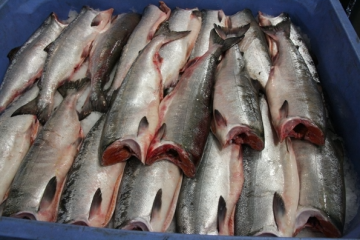 Our state is home to the nation’s last stronghold of wild salmon and, for the most part, we have managed our fisheries well. For generations Alaskans have sustainably harvested millions of wild salmon while this amazing fish continues to return to their native streams, spawn and rejuvenate the population every year. Tasked with developing policies that protect our salmon resource, the Alaska Board of Fish uses the basic principles of sustainable yield and conservative management to drive decision-making and, by-and-large, it has worked. But managing the harvest of salmon is only part of the equation. Ensuring our salmon runs remain strong also means protecting the habitat they depend on, from the wetlands at the headwaters of the streams they spawn all the way to the ocean where they spend the majority of their lives. In recent years, pressure to allow mining and damming interests to set up shop in and around our prolific salmon streams has increased greatly, with proposed projects like the Pebble Mine, Susitna dam, and the Chuitna Coal strip mine leading the charge. Read the rest here 17:15
Our state is home to the nation’s last stronghold of wild salmon and, for the most part, we have managed our fisheries well. For generations Alaskans have sustainably harvested millions of wild salmon while this amazing fish continues to return to their native streams, spawn and rejuvenate the population every year. Tasked with developing policies that protect our salmon resource, the Alaska Board of Fish uses the basic principles of sustainable yield and conservative management to drive decision-making and, by-and-large, it has worked. But managing the harvest of salmon is only part of the equation. Ensuring our salmon runs remain strong also means protecting the habitat they depend on, from the wetlands at the headwaters of the streams they spawn all the way to the ocean where they spend the majority of their lives. In recent years, pressure to allow mining and damming interests to set up shop in and around our prolific salmon streams has increased greatly, with proposed projects like the Pebble Mine, Susitna dam, and the Chuitna Coal strip mine leading the charge. Read the rest here 17:15
Fishermen in the North look forward to leaving EU
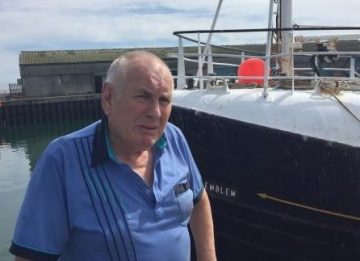 In Portavogie on the Ards peninsula a new flag is flying proudly among the British union and Red Hand of Ulster flags fluttering from the lamp posts in this overwhelmingly unionist and loyalist fishing village in Co Down. It’s the “Fishing for Leave” ensign hoisted on the masts of many of the 40 or so trawlers that berth in this harbor. This is staunchly Brexit territory. Sitting on a bollard beside his trawler, the Golden Emblem, Harold Young says he doesn’t know of one fisherman who voted Remain in the referendum on whether or not the UK should stay in the European Union. Because of EU regulations and quotas he is mainly restricted to fishing for Dublin Bay prawns – more technically termed nephrops and also called the Norway lobster – and now believes there is a chance he will be able to catch whatever the sea offers up. Some years ago he was fined £20,000 (€22,000) for breaching a whitefish quota he had at the time, so the decision to get away from the bureaucracy of Brussels gladdens him. “Like the farmer, the fisherman should be able to land whatever is in season,” he says. Read the rest here 13:34
In Portavogie on the Ards peninsula a new flag is flying proudly among the British union and Red Hand of Ulster flags fluttering from the lamp posts in this overwhelmingly unionist and loyalist fishing village in Co Down. It’s the “Fishing for Leave” ensign hoisted on the masts of many of the 40 or so trawlers that berth in this harbor. This is staunchly Brexit territory. Sitting on a bollard beside his trawler, the Golden Emblem, Harold Young says he doesn’t know of one fisherman who voted Remain in the referendum on whether or not the UK should stay in the European Union. Because of EU regulations and quotas he is mainly restricted to fishing for Dublin Bay prawns – more technically termed nephrops and also called the Norway lobster – and now believes there is a chance he will be able to catch whatever the sea offers up. Some years ago he was fined £20,000 (€22,000) for breaching a whitefish quota he had at the time, so the decision to get away from the bureaucracy of Brussels gladdens him. “Like the farmer, the fisherman should be able to land whatever is in season,” he says. Read the rest here 13:34
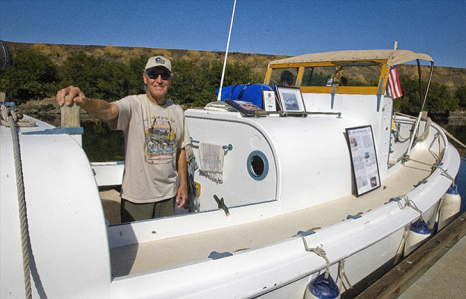
Restoring history – 36-foot U.S. Coast Guard Motor Lifeboat CG36391
When Glen Cathers’ wife Naomi asked him what he would choose if he could have anything in the world, he replied, “I want a motor lifeboat.” “Let’s do it,” she said. A month later, they found CG36391 in Astoria, a 36-foot lifeboat built in 1934. It was “in major disrepair,” hardly recognizable. “I could see that bull nose on it, I knew right then what it was. It was the real deal.” They purchased it and began what would become a seven-year process of restoration. “It’s new from the waterline up,” he said of the boat as it floated tied up to the visitor dock at The Dalles Marina. It contains parts from 11 different boats. “Piece by piece, I collected all the parts we needed,” he said. The restoration was completed in 2012. Today the boat looks as it did in 1939. “A little more varnish maybe,” Cathers chuckled. “That was the first thing the crews did, get rid of the varnish.” Read the story here 11:46
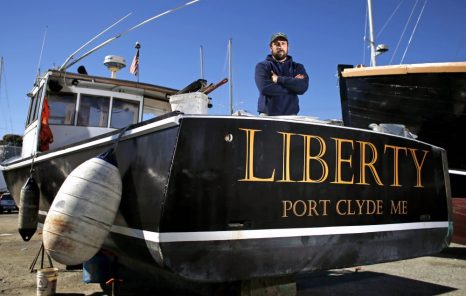
This lobsterman’s boat was sunk 3 times in 7 weeks. He says he knows who did it.
Tony Hooper, who has lobstered out of area harbors on and off for years, says he knows who sank his 35-foot lobster boat, Liberty, three times in seven weeks: a fellow fisherman operating out of Port Clyde, one of three villages that constitute this peninsular town that extends 15 miles south of Rockland. The fisherman, Hooper alleges, turned a routine dispute over the placement of lobster traps into an ongoing drama that’s turned heads up and down the Maine coast. “The guy has a personal grudge against me, and I don’t know why, because I’ve never done anything to the guy,” Hooper says. “He’s just a young, arrogant kid who didn’t like it when I called him out for messing with my traps.” Boat sinkings are rare in the Maine lobster fishing community, but when they occur they often result from disputes between lobstermen from different harbors over fishing turf. But sinking the same lobsterman’s boat three times in quick succession – once on the very night it was repaired and put back on its mooring – is extremely rare. Read the story here 09:48

Interesting Interview with Fisherman/UFC veteran Cody “AK Kid” McKenzie
Can you run down some of work you’ve done outside MMA? I’ve had lots of jobs, I’ve roofed, I’ve fished, cut wood, I can’t think of all the jobs I’ve done. I actually used to have a car washing business when I was really young. I grew up around gill netters, gill netting for salmon, for red, sockeyes, all different kinds of salmon, and then I also seine for salmon, which is just a different type of fishing, and then last year, after the seine season, I went up to the Bering Sea and did king crab out there. That’s the one everyone watches on The Deadliest Catch. It was good work, it was hard work, long hours, but I enjoyed it a lot. I really like fishing. A lot of people in the fight game try to insult me, saying ‘Go back fishing, you’re not a fighter,’ and I just get a good laugh, because it’s like, yeah I enjoy fishing, it’s good hard work, I wasn’t born with a silver spoon, I worked for a living, and nowadays some of these MMA fighters think that’s a bad thing. It’s kinda become a rich kids’ sport where you need twelve coaches and a nutritionist, it’s a different sport from when I got into it for sure, but to each their own. Read the interview here 09:16
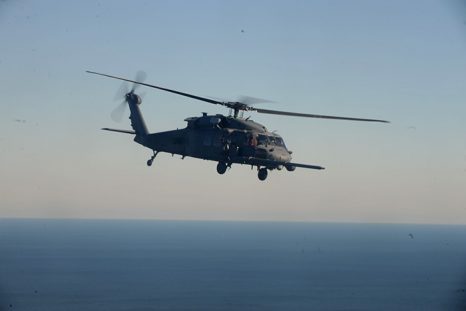
The 106th Rescue Wing: Pararescueman from ‘The Perfect Storm’ will speak in Westhampton October 22
In one of the dramatic scenes in the movie The Perfect Storm, a rescue helicopter appears, hovering in the wind and rain over the 80-foot seas—possibly the largest seas ever off the Northeastern shore—so its occupants can attempt a daring rescue of two women and a man aboard a 30-foot sailboat that has foundered down below. There are five men aboard this helicopter—Lt. Colonel Graham Buschor, it’s co-pilot, Lt. Colonel David Ruvola, the other co-Pilot, Jim Mioli, the flight engineer, and two pararescuemen, John Spillane and Rick Smith. Over the foundering ship, Spillane and Smith fearlessly leap out of the chopper carrying 110- pound packs on their backs, splash into the water and proceed to put the three victims into baskets that have been lowered by cable. Then, above the rolling, violent seas, the victims are choppered over a nearby Coast Guard ship and lowered down to safety. Of course, this story is not over. The chopper returns and with the same rescue method, cables up the pararescuemen. But now the chopper is running low on fuel. An attempt is made to conduct a mid-air refueling with a propeller driven Hercules four-engine refueling plane that comes over. But the wind is so high, the effort fails. They try again and again to link up, but in the end, the helicopter goes down into the ocean. And though four of the five men onboard are rescued from these enormous seas by the Coast Guard cutter, the fifth man is lost, never to be seen again. Of course, there are other dramatic activities going on in this monster storm—indeed, the main plot of The Perfect Storm is of the men aboard the Andrea Gail fishing boat, out of Gloucester, Massachusetts, who are also never seen again. Read the story here 18:15
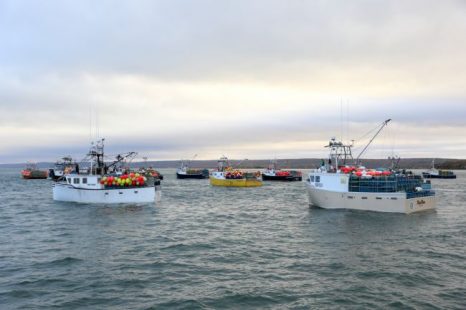
PHOTOS: Lobster season Dumping Day in Digby
Lobster boats loaded with traps and gear steamed out of Digby Harbour for the 8:45 a.m start of the annual lobster fishing season in the western end of LFA 35 on Friday, Oct. 14. Harbour manager Ed Chisholm estimated nearly 75 lobster boats left the harbour for the Bay of Fundy with several dropping the first few strings in the Basin before heading out through Digby Gut. “This morning’s departure went smoothly considering the large number of boats leaving the wharf,” Chisholm said. “Most fishermen have been here before so know what they are dealing with.” Digby is the last wet port as you head up the Bay of Fundy and fishermen from other parts of LFA 35 make use of Digby port during the lobster season for that reason Chisholm said. Photo gallery, read the rest here 15:36
Shellfish harvested from RI waters test negative for toxins
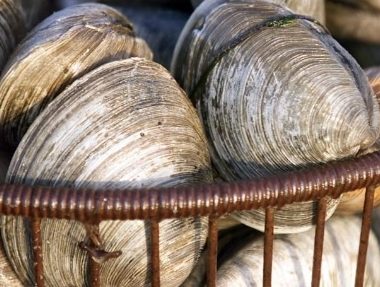 While Rhode Island’s shellfishing industry is still on hold as toxin levels in area waters remain high, the Rhode Island Department of Environmental Management reported Friday that shellfish meat tested negative for toxic phytoplankton. “Every time we have found toxicity in the water column, we’ve never found it in the shellfish,” Angelo Liberti of the Rhode Island Department of Environmental Management told NBC 10 News. A harmful algae bloom forced a precautionary closure of Narragansett Bay, Mt. Hope Bay, Kickemuit River, Sakonnet River, as well as their tributaries, on Oct. 6 and Oct. 7. Authorities hope that the shellfishing industry will be fully operational again soon. That’s good news for shellfishermen, who have been out of work since the closure was enacted. If the remaining shellfish samples come back negative, they could be back in business as soon as next week. Read the story here 15:05
While Rhode Island’s shellfishing industry is still on hold as toxin levels in area waters remain high, the Rhode Island Department of Environmental Management reported Friday that shellfish meat tested negative for toxic phytoplankton. “Every time we have found toxicity in the water column, we’ve never found it in the shellfish,” Angelo Liberti of the Rhode Island Department of Environmental Management told NBC 10 News. A harmful algae bloom forced a precautionary closure of Narragansett Bay, Mt. Hope Bay, Kickemuit River, Sakonnet River, as well as their tributaries, on Oct. 6 and Oct. 7. Authorities hope that the shellfishing industry will be fully operational again soon. That’s good news for shellfishermen, who have been out of work since the closure was enacted. If the remaining shellfish samples come back negative, they could be back in business as soon as next week. Read the story here 15:05
F/V Cornelia Marie will not be featured on “Deadliest Catch” Season 13
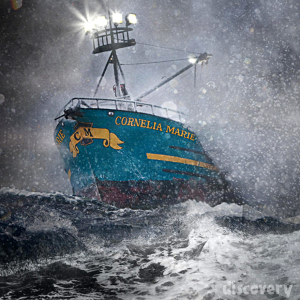 From Josh Harris – Thank you to all for your patience. I had a family matter to attend to, so I have had to leave the boat to come home and take care of a few things. First and foremost, we want to thank everybody for all of your messages and wishes. The Cornelia Marie captains and crew really appreciate and are humbled by your outpouring of support. I am here today to set things straight in regards to the filming of Season 13 of Deadliest Catch. The Cornelia Marie and her crew are making their way out to the fishing grounds today. We do not have a camera crew aboard this king crab season. This was not our decision, and it was not made by the owners nor the captains of the Cornelia. This was not a dispute over money, this was simply a decision made by production Discovery. They have creative control over pretty much everything that airs on Deadliest Catch, and we respect that. We are fishermen and we will be doing what we love to do this king crab season, but we will be doing it alone. Video, Read the rest here 12:41
From Josh Harris – Thank you to all for your patience. I had a family matter to attend to, so I have had to leave the boat to come home and take care of a few things. First and foremost, we want to thank everybody for all of your messages and wishes. The Cornelia Marie captains and crew really appreciate and are humbled by your outpouring of support. I am here today to set things straight in regards to the filming of Season 13 of Deadliest Catch. The Cornelia Marie and her crew are making their way out to the fishing grounds today. We do not have a camera crew aboard this king crab season. This was not our decision, and it was not made by the owners nor the captains of the Cornelia. This was not a dispute over money, this was simply a decision made by production Discovery. They have creative control over pretty much everything that airs on Deadliest Catch, and we respect that. We are fishermen and we will be doing what we love to do this king crab season, but we will be doing it alone. Video, Read the rest here 12:41






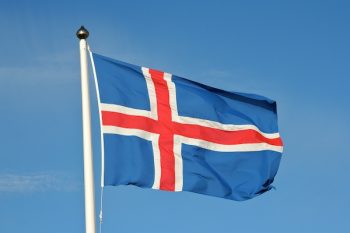 The Icelandic fleet is set to stop fishing next month after union members voted overwhelmingly in favor of strike action over falling earnings. Ninety-one percent of members of the Icelandic Union of Marine Engineers and Metal Technicians voted for a strike, as did 90 percent of the members of associations affiliated to the Seamen’s Union representing deck crews. The ships officers’ union had previously voted to accept the terms of an agreement with owners’ federation SFS (Iceland Fisheries). There are several issues that the pro-strike unions are deeply dissatisfied with, including the percentage that crews of new vessels pay towards construction costs, which is felt to be excessive, not least because there is a number of new vessels set to join the Icelandic fleet over the coming year, with both freezer and fresher trawlers being built at yards in China and Turkey for Icelandic operators.
The Icelandic fleet is set to stop fishing next month after union members voted overwhelmingly in favor of strike action over falling earnings. Ninety-one percent of members of the Icelandic Union of Marine Engineers and Metal Technicians voted for a strike, as did 90 percent of the members of associations affiliated to the Seamen’s Union representing deck crews. The ships officers’ union had previously voted to accept the terms of an agreement with owners’ federation SFS (Iceland Fisheries). There are several issues that the pro-strike unions are deeply dissatisfied with, including the percentage that crews of new vessels pay towards construction costs, which is felt to be excessive, not least because there is a number of new vessels set to join the Icelandic fleet over the coming year, with both freezer and fresher trawlers being built at yards in China and Turkey for Icelandic operators. 